Photos: Highlights from ICFF 2010

Qlocktwo by Andreas Funk and Marco Biegert: The Qlocktwo tells time with words instead of numerals. The clever arrangement of letters spells out the hour “the same way people actually talk,” Funk said. The LED backlight has a manual brightness control as well as a light sensor so the face can automatically adjust depending on ambient light. The front panel is removable and comes in multiple colors and languages. When you tire of running late in English, you can run late in French, Russian or Arabic. (Michael Nagle / For The Times)
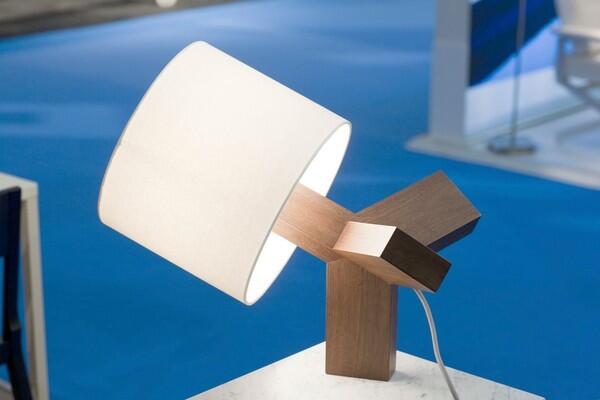
Rook lamp from Blu Dot: Blu Dot co-founder and chief executive John Christakos calls the Rook lamp a happy accident. A chunk of wood -- part of a base for a floor lamp -- was abandoned in a work room. Someone randomly discarded a lampshade on top of that trash. Then someone else noticed: Hmmm, that combination looks good. Rook can stand on three legs with its shade pointed up, or it can balance on a single edge with the shade cantilevered to the side, “like some Joseph Shapiro sculpture,” Christakos said. “It’s just a cute little number.” (Michael Nagle / For The Times)
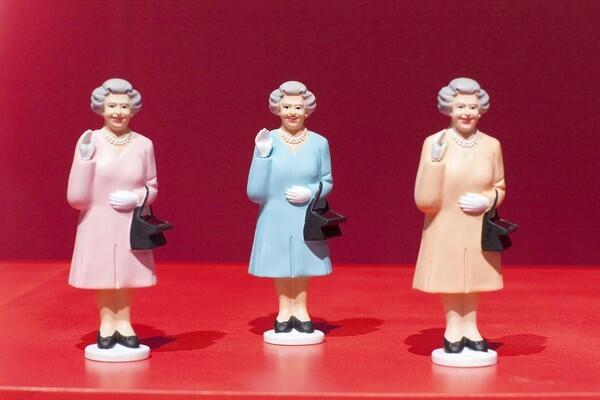
Solar Queen from Kikkerland: It’s the greenest wave in the royal family. The Solar Queen dutifully gestures to her subjects with a swiveling wrist powered by a miniature solar panel atop her black handbag. (Michael Nagle / For The Times)

Advertisement

Step from Design House Stockholm: The concept behind Karl Malmvall’s new piece: With so much stuff crammed into closets, why buy an ugly stepladder that needs to be put away? Why not create a functional piece that looks good enough to leave out? His stepladder looks like steel but is made of carved wood finished in high-gloss red, black or white. It folds to 2 inches thick and comes with a peg to hang on the wall, where it can pop as a graphic element or, if your wall color is right, disappear into the background. (Michael Nagle / For The Times)

Picture Wall wallpaper byDeborah Bowness: Bowness won a following with photo-realistic wallpaper depicting bookshelves and lamps in 2D. This year at ICFF, the British designer premiered a design replicating her favorite framed artworks, photographed in sections and reassembled

Mehndi rug from Malene B: Malene Barnett, pictured, said her rug was inspired by a friend’s wedding in Mumbia, India, for which her hands were dyed as part of a traditional mehndi ceremony. She translated the intricate patterns of henna on her palms into threads of Tibetan wool and Chinese silk. The hand-knotted design comes in the cream palette pictured here as well as in an electric red. (Michael Nagle / For The Times)

Telephone lamp from Thelermont Hupton: Originally designed as an exclusive for the Liberty of London department store, these table lamps from the British design studio Thelermont Hupton are headed for a worldwide audience. With playful glass shades and exposed bulbs, the lights were among dozens of designs anticipating a market in the mood for a lighthearted touch. (Michael Nagle / For The Times)
Advertisement

The Book light by Myungseo Kang: Kang graduated two years ago from the Central St. Martin’s College of Art and Design, the London arts school that counts fashion designer Stella McCartney, actor
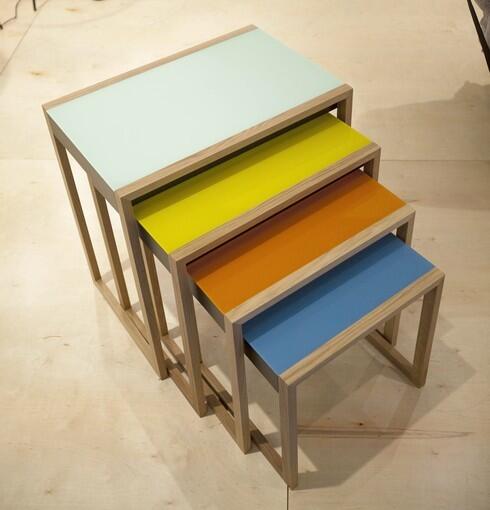
Josef Albers nesting tables, 1926-27, from Ameico: These tables illustrated two trends at ICFF this year: the rediscovery of classic designs and an optimistic tide of color flowing through furniture collections. Albers was a student of the Bauhaus who went on to lead the school’s glass work workshop in the 1920s and, later, the art school at Yale. In reissuing the tables, Ameico replaced his glass tabletops in favor of lacquered acrylic, still framed in white oak. (Michael Nagle / For The Times)
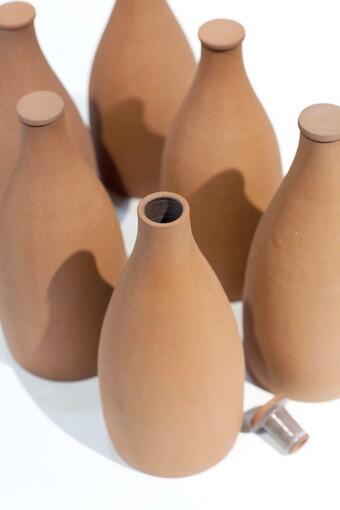
Coal Pot Bottles from the New Caribbean Design collection: One of the pleasant surprises of the show was a booth showcasing Caribbean artists, whose traditional crafts carried a contemporary flair. Stella Hackett, a Barbados artist and graduate of the Rhode Island School of Design, showed hand-formed bottles made of red clay. Traditional island cooking, Hackett said, calls on pots with a cavity for hot coals at the bottom -- pots made with the same red clay. Glazed interiors and glazed stoppers made Hackett’s bottles functional, but the vessels’ simple sculptural appeal were what caught the eye. (Michael Nagle / For The Times)

Maroon baskets from the New Caribbean Design collection: Ivelyn Harris, who runs Nanny of the Maroons Traditional Crafts in Jamaica, showed baskets made of hand-stitched coconut palm that were at once primitive and sophisticated. (Michael Nagle / For The Times)
Advertisement

Free-standing basket from Mio: Mio’s new basket is a single piece of carefully cut steel that ships flat and then can be bent into shape by the consumer. The piece can be used as an umbrella holder, perhaps, or lined with a bag and deployed as a trash container. The flat-pack design reduces manufacturing waste, packaging and shipping costs. (Michael Nagle / For The Times)

Bike basket from Mio: Jaime Salm, co-founder of the

Hats from Mio: Jaime Salm, co-founder of the

Tom Dixon demonstration: Dixon was one of several designers who used ICFF to encourage a discussion not only about how home furnishings look but also how they are made. The point: It’s so much easier to get a design from drawing board to customer these days. His studio set up a “flash factory” where workers fitted together paper-like pieces of acid-etched steel and brass into pendant lights and candle holders. Those designs were sold on the spot for $150 and $50 each, respectively. No factory, no warehouse, no wholesaler, no retailer. (Michael Nagle / For The Times)
Advertisement

Void light from Tom Dixon: The latest lighting from Dixon performed something of a magic trick: Not only did the orbs seem to hover weightlessly overhead, but their gentle illumination appeared to emanate from solid metal. The British designer said the brass, stainless steel and copper pieces are nods to the gold, silver and bronze that will be handed out at the 2012

Teacups by Hanna Tonek Bonnett: For 2010, London-based Bonnett riffed on her own 2008 design, giving dainty teacups a bit of an edge. Now a rim of white gold drips messily into the tidy flowers below.
Read complete reports from the 2010 International Contemporary Furniture Fair. (Michael Nagle / For The Times)
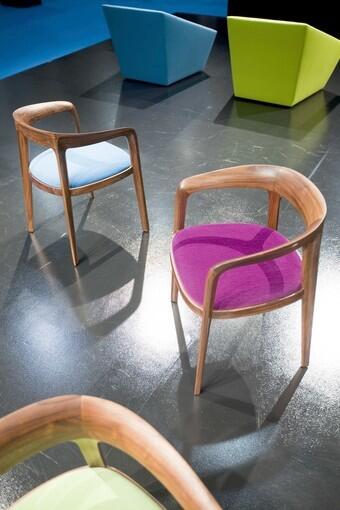
Corvo chair for Bernhardt: At the Bernhardt booth, the Corvo chair by Noe Duchaufour-Lawrance echoed two trends from the Milan furniture fair in April: bright colors and an emphasis on craftsmanship. The traditional American walnut silhouette was paired with seats in fuchsia, sky blue and lime green. With consumers still skittish about investing in furniture, many manufacturers have been emphasizing craftsmanship -- the person and the story behind the piece -- to differentiate their collections from mass-market, machine-made imports. Bernhardt produced a five-minute film documenting how the chair’s shapely contours made manufacturing with modern computer-numeric controlled machines impossible, and how it ultimately was constructed by hand using 15 tools to carve and finish the wood. (Michael Nagle / For The Times)

Lamps by Caleb Siemon: Siemon’s new collection of pendant lights included clear and golden fixtures whose crystal was more than an inch thick. The depth of the crystal allowed for fuller bubbles and more interesting patterns of light. (Michael Nagle / For The Times)
Advertisement

Lamps by Caleb Siemon: Siemon, the artist behind the United Glass Blowing studio in
Read complete reports from the 2010 International Contemporary Furniture Fair. (Michael Nagle / For The Times)

Toro chair from Blu Dot: Blu Dot departed from its recent angular, minimalist metal furniture and premiered the gentle curves of Toro, a beech frame fitted with leather seat made by a Minneapolis saddle maker. Co-founder and chief executive John Christakos said his team wanted to create a chair that had a high back, for maximum comfort; a modest footprint, so it could work in small spaces; and a softer, more supple finish, for a sense of luxury that will still sell for less than $1,000.
Read complete reports from the 2010 International Contemporary Furniture Fair. (Michael Nagle / For The Times)



